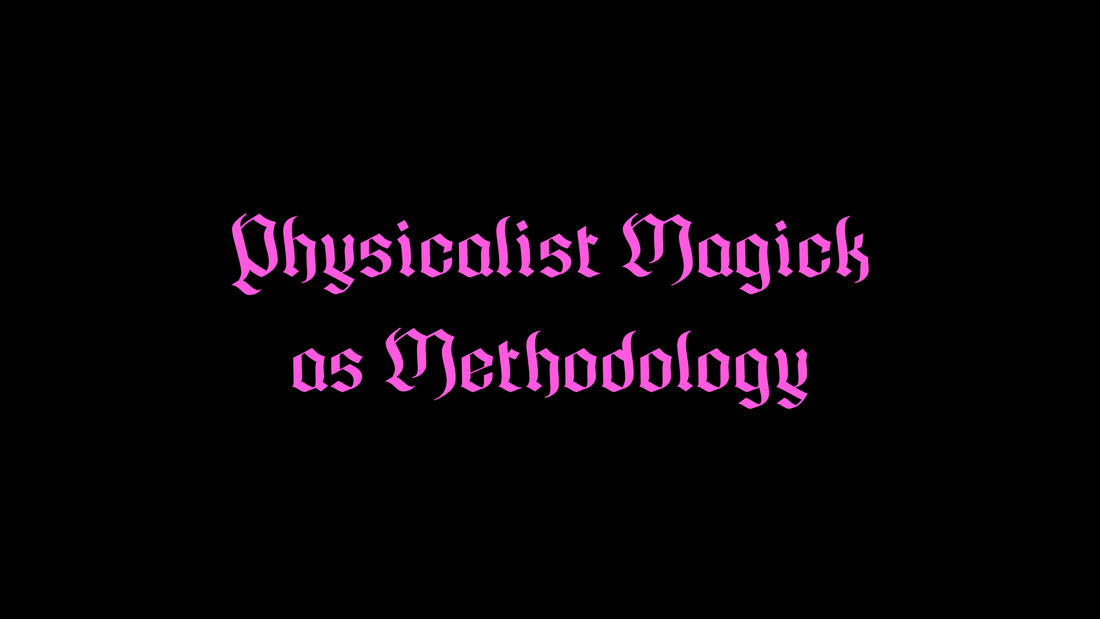
Physicalist Magick as a Methodology
Share
In The Secular Occultist’s Handbook of Physicalist Magick, Jangled Jester redefines magick as a physical process of transformation, rooted in the interplay of form, force, and change. Traditionally, magick is seen as a mystical power — existence’s ability to morph, express, and reflect. Aleister Crowley famously defined magick as the act of aligning with one’s “True Will.” Jangled Jester expands this, embracing inanimate and unconscious systems, proposing that magick is not just willful but inherent in all physical processes. In this view, magick is fundamentally physical — an educated guess grounded in observable patterns of the universe.
What Is the Non-Physical?
The question of the “non-physical” drives Jangled Jester’s philosophy. If the physical world is all we can observe, measure, and interact with, what could lie beyond it? The challenge is that unobservable phenomena — whether divine realms or ghostly apparitions — cannot be confidently labeled as non-physical. Agnosticism becomes a useful stance here: we suspend judgment about the unobservable, focusing instead on what we can know. Physicalism posits that, based on the step-by-step processes governing all observable systems (from chemical reactions to ecosystems), unobservable phenomena likely follow similar material patterns.
In this framework, it doesn’t matter whether existence is a celestial plane of angels or a mortal world of flesh and decay. If it involves steps like sequences of movement, force, shape, or change, then it’s physical. As Walt Whitman poetically declared, “body is soul.” The spirit or essence of anything, from a human body to a bustling city, arises from the interaction of physical forms. Existence and essence are inseparable, built from the interplay of matter and energy.
Defining the Physical
To be physical is to be governed by principles like force, energy, motion, and thermodynamics that are concepts central to physics, from Newton’s laws to quantum mechanics. But is our current list of physical properties exhaustive? Could unobservable phenomena possess physical traits we haven’t yet defined? Physicalism urges us to remain open to new “physical realizations.” For instance, phenomena we can’t yet measure might still involve motion or energy, awaiting discovery within an expanded physics.
| State | Description | Example of Physicality |
| Consciousness | A dynamic, ever-changing state of awareness | Shifting from being fully alert to being drowsy |
| Love | A series of emotional transitions |
Moving from attraction to attachment
|
| Emotions | Constantly in motion, transitioning from one to another | Shifting from joy to surprise to excitement |
Another fun exercise to apply this strategy to is phenomena like ghosts, gods, and souls:
| State | Description | Example of Physicality |
| Ghost | The spirit of a deceased person living on in another form after biological death | Ghost walking down a hallway (motion), apparitions (form), a ghost remembers its life indicating memory (storage) and (space) |
| God | A supreme entity |
Classic traits of God are power, knowledge, goodness, and morals, all measurable |
| Soul | The essence or quality of an entity | Quality is a measurement of distinction, like a comparison and contrast |
Physicalist Magick: The Art of Mundane Transformation
What is physicalist magick? Jangled Jester invites you to see magick as the interplay of body and system — existence shaped by structured, step-by-step processes. By observing reality’s patterns and formulae, you uncover what Jester calls mundane, physicalist magick: the power of transformation inherent in all things, from atoms to ecosystems.
A Universal Framework
Physicalist magick is versatile, bridging secular and spiritual worldviews. Its focus on processes and sequences of change applies to religious rituals, spiritual practices, or agnostic pursuits like art and science. Jangled Jester’s blog adopts a nonreligious lens, but the philosophy seamlessly integrates with beliefs in God, heaven, or paranormal phenomena. The only requirement? Acknowledge that all phenomena, divine or mundane, unfold through embodied steps.
This magick requires no ritual initiation because it’s universal. You were born with it, as was every entity whether animate or inanimate, conscious or not. Physicalist magick is a law of existence, not a privilege. Each of us is a unique expression of magick, shaped by our bodies, limits, and potential. Unlike Aleister Crowley’s view of magick as an act of conscious “True Will,” Jester’s vision is broader, embracing unconscious and inanimate transformations. A river carving a canyon or a neuron firing in your brain — these, too, are magick.
Why It Works
By recognizing magick in everyday processes, we tap into a profound truth: transformation is constant and accessible. This perspective dismantles Crowley’s narrow focus on intentional will, revealing the power of mundane change. It offers hope, courage, and determination, showing us that even in our most stagnant moments, we can reshape ourselves and our world.
Physicalist magick empowers you to see reality as a canvas of interconnected systems. Observe the steps, harness the formulae, and create change whether through a deliberate ritual, a scientific experiment, or a work of art. You are magick, and the universe is your medium.
Physicalist Magick in Practice
Let's assess a common, mundane practice of magick via the design and system of a mundane rose.
A ROSE
STEP ONE: Discover The Design

What are the parts?
The design of the rose is in its framework. The pieces are: flower, stem, thorns, leaves.
These make the body of the rose.
Alternative terms: structure, form, body, existence, architecture, pattern
STEP TWO: Study the System

The system of the rose is the way its pieces and parts come together as a working, transformative process or system.
How does the system change, connect, function?
The system of the body mixes an essence or 'spirit' based on the sum of its parts. Here, the spirit of the rose is fragrance, cultural meaning, and beauty.
Alternative terms: process, recipe, essence, quality, nature, spirit
STEP THREE: Mapping Magick

